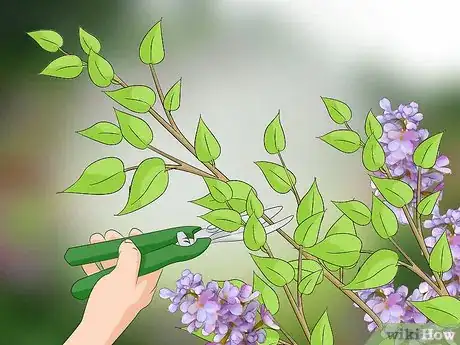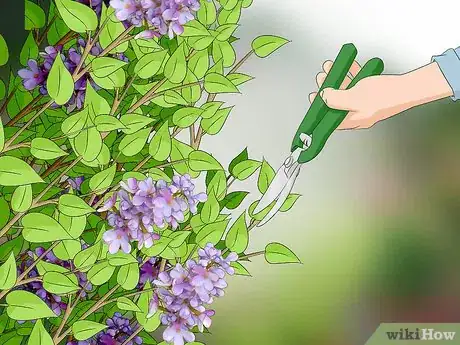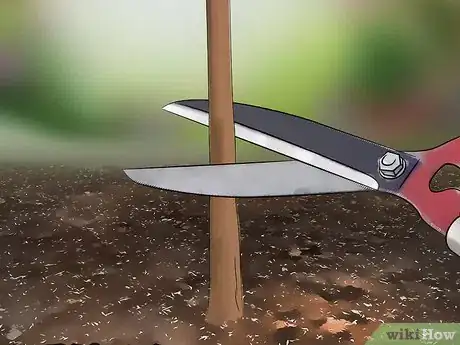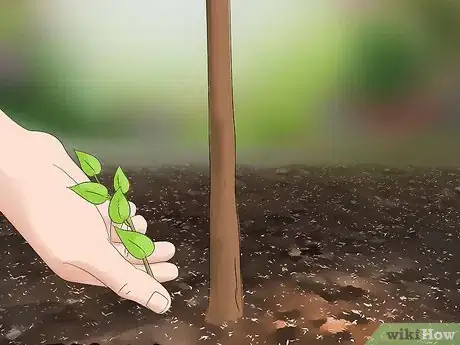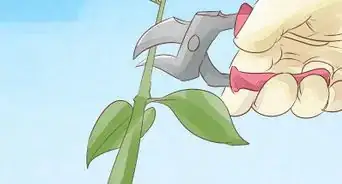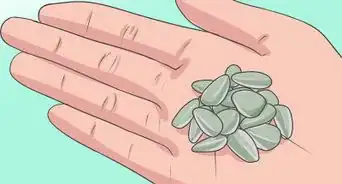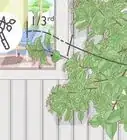This article was co-authored by Steve Masley. Steve Masley has been designing and maintaining organic vegetable gardens in the San Francisco Bay Area for over 30 years. He is an Organic Gardening Consultant and Founder of Grow-It-Organically, a website that teaches clients and students the ins and outs of organic vegetable gardening. In 2007 and 2008, Steve taught the Local Sustainable Agriculture Field Practicum at Stanford University.
wikiHow marks an article as reader-approved once it receives enough positive feedback. This article received 38 testimonials and 89% of readers who voted found it helpful, earning it our reader-approved status.
This article has been viewed 518,461 times.
Fragrant, colorful lilacs are easy to grow in most regions. Whether your lilac is a shrub or a small tree, it will need to be regularly pruned in order to maintain a healthy shape and size. To prune lilacs, get to work in the spring: cut fresh flowers for bouquets, nip off the longest stems, and thin out any weak stems at the base. Avoid pruning late in the summer or fall since doing so can limit future growth.
Steps
Doing an Annual Pruning
-
1Cut fresh flowers in the spring. When lilac flowers reach their peak and are just this side of fading out, cutting them to create indoor bouquets actually helps the plant. Left on their stems, the flowers will die but continue sapping energy that could be spent on new growth. So don't feel guilty or wasteful when you go outside with your hand trimmers to take off the prettiest flowers - you're doing just the right thing for your lilac bush or tree.[1]
- Another term for this type of pruning is deadheading. In addition to pruning flowers just past their peak, prune those that are already dying.
- Make the cut just at the base of the flowers.
- You can disinfect your tools before you prune to avoid spreading disease to your lilac bush. Simply wipe it down with a disinfectant spray or rubbing alcohol.
-
2Nip off the long stems. Take a look at your lilac bush or tree and assess whether there are any extra-long but healthy-looking stems that need to be cut back. Doing so will help the lilac keep its pretty shape. The process of cutting back the stems a bit is called tipping off. Use a hand clipper to cut longer stems back to the next closest pair of side shoots.[2]
- This means you'll be trimming the stem back beyond the flowered part, and all the way down to where side shoots are growing off.
- If A long stem doesn't have side shoots closer to the base, trim it back to the closest node or bud, where new shoots will sprout.
- Tipping encourages lilacs to sprout new healthy, bushy growth near the cut.
Advertisement -
3Thin the lilac. Search for dead or diseased stems. If you see any limp, brown or diseased stems in your lilac bush or tree, cut them out close to the base. This process is called thinning, and it helps the plant by allowing fresh air to circulate through the plant and removing dying foliage that sap its energy.[3] [4]
-
4Don't prune later in the summer or fall. This annual pruning should take place during spring (May or June in the northern hemisphere, around September to November in the southern hemisphere). Such pruning will encourage the development of new buds, which will continue maturing over the year before they bloom the following spring. However, if you prune too late in the summer, you risk cutting away some of this new growth - hence causing next spring's bloom to fall short.[5]
- If you prune in the fall or winter, your lilac may not produce flowers at all.
Rejuvenating an Overgrown Lilac
-
1Take an assessment of your lilac. If it's old, overgrown, or unshapely, giving it a rejuvenating pruning will help restore it to a healthier and more attractive state. This type of pruning goes beyond a lighter annual pruning to severely cut the bush or tree back, allowing for new growth to occur.[6]
- Do your assessment in early spring, before the lilac has come back to life. This is the best time of year for a deeper pruning.
- Keep in mind that doing a rejuvenating pruning will mean losing the maturing buds that would otherwise turn into this spring's flowers. Though you might sacrifice this year's blossoms, you'll be rewarded in the following seasons with better growth and flowers.
-
2Determine if your lilac was grafted. Some lilacs are grafted with other varieties in order to produce a particular flower shape or color. Grafted plants need to be pruned with a bit more care, since cutting below the grafted area will disturb the graft and change the way your plant grows. Look for an area on one of the lilac's main trunks where there's a noticeable difference in bark near a lump. This is probably the graft. If you see no such thing, the plant likely hasn't been grafted, so there's no need to look out when you make cuts.[7]
-
3Use clippers to trim the plant close to the ground. If the trunks are very thick, you may need a saw. Cut each branch back by 1/3 to 1/2. The lilac will grow back, but it'll take a season or two.[8]
- If you discovered that your plant was grafted, be sure not to cut below the graft.
-
4Cut back the suckers. Suckers are baby trunks growing out from the original plant, or sprouting from the ground close by. Cut these back all the way to the base of the trunk or the ground to prevent them from getting any bigger. Suckers take away energy from the rest of the plant. A healthy lilac bush or tree should have no more than 2 or 3 large trunks.[9]
-
5Fertilize the plant afterwards. If you have heavily pruned your lilacs, you should fertilize the plant afterwards to restore the pH balance in the soil. You can use compost, manure, or a prepackaged blend around the plant to help it recover.[10]
Expert Q&A
Did you know you can get expert answers for this article?
Unlock expert answers by supporting wikiHow
-
QuestionWhen should you cut back a lilac tree?
 Maggie MoranMaggie Moran is a Professional Gardener in Pennsylvania.
Maggie MoranMaggie Moran is a Professional Gardener in Pennsylvania.
Home & Garden Specialist
-
QuestionHow do you cut lilacs?
 Maggie MoranMaggie Moran is a Professional Gardener in Pennsylvania.
Maggie MoranMaggie Moran is a Professional Gardener in Pennsylvania.
Home & Garden Specialist
-
QuestionCan you cut back lilac bushes in the fall?
 Maggie MoranMaggie Moran is a Professional Gardener in Pennsylvania.
Maggie MoranMaggie Moran is a Professional Gardener in Pennsylvania.
Home & Garden Specialist
Warnings
- Do not remove too many stems. The general rule is to remove approximately a third of your stems and to balance the removal of old and new stems. Since old stems produce flowers, you want to keep many around. But trimming all your new stems will result in the plant failing to bloom in the future.⧼thumbs_response⧽
Things You'll Need
- Pruning shears
- Small garden saw or hand saw
- Gardening gloves
References
- ↑ https://www.finegardening.com/article/pruning-lilacs
- ↑ https://www.finegardening.com/article/pruning-lilacs
- ↑ Steve Masley. Home & Garden Specialist. Expert Interview. 20 March 2019.
- ↑ https://savvygardening.com/tips-for-pruning-lilacs/
- ↑ https://www.goodhousekeeping.com/home/gardening/advice/g60/pruning-tips-0307/?slide=1
- ↑ https://lancaster.unl.edu/hort/articles/2005/prunelilacs.shtml
- ↑ https://www.finegardening.com/article/pruning-lilacs
- ↑ https://lancaster.unl.edu/hort/articles/2005/prunelilacs.shtml
- ↑ https://savvygardening.com/tips-for-pruning-lilacs/
About This Article
To prune your lilacs, start deadheading in early-to-late spring by cutting the flowers at their base just after they’ve reached their peak. You should also cut any flowers that are already dying so they don’t sap energy that could be used for new growth. Then, use a hand clipper to cut back any extra-long stems all the way down to where side shoots are growing. Tipping off your lilacs in this way will encourage them to sprout new, healthy growth near those cuts. Finally, thin any dead or diseased stems by cutting them off close to the base. To learn from our Horticulturist reviewer how to rejuvenate your overgrown lilac, keep reading!

